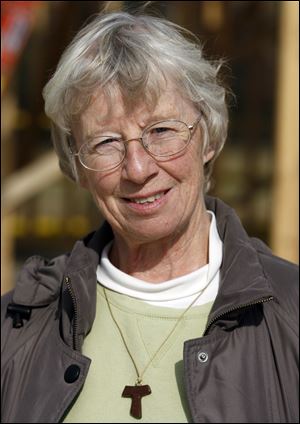
Straw-bale house builders unafraid of big bad winds
11/4/2010TIFFIN - Looking out from the framework of what will be a passive, zero-energy, straw-bale house, Sister Jane Frances Omlor can't help but think that raising three little pigs outside might add the perfect touch.
Of course, she and others at the Franciscan Earth Literacy Center are prepared to prove the fable wholly inaccurate or at least "shake it up a little." They are building a straw house that not only won't blow down, they believe it will be the warmest, coziest, most environmentally friendly house in Tiffin.
"This is an educational facility that we're building. It's going to be used for demonstration," said Sister Jane, who helped build a straw-bale chapel in West Virginia 15 years ago. "I really believe you can talk day and night, but if you can show people and you actually have the guts to go out there and do it - it takes guts."
Mike Conner, chief of the earth literacy center, a ministry of the Sisters of St. Francis in Tiffin, said he hopes that when people see the straw-bale house, they'll not only learn about green construction, they'll want to replicate it.
"We want this facility to be attractive," he said. "We want people when they see it to go, 'Wow. How'd they do that? I want to do something like that.'•"

Sister Jane Frances Omlor
Designed in the style of "a little Ohio farmhouse," as Sister Jane put it, the 1,500-square-foot home will have many basic features of a traditional home - two bedrooms, 1.5 bathrooms, a kitchen, and living room - but it will lack a furnace and air conditioning system, to name two.
Instead, the house will be heated and cooled with an energy-recovery ventilation system or electric air-exchange unit. It will have electricity but will rely on the sun for the power it needs.
"We're not going to use any more energy than we can produce ourselves," Sister Jane said.
The house is being built on a concrete slab, but underneath that slab is four feet of a material called millcell, a product from Germany made from recycled glass. It prevents cold from radiating up into the house and helps keep heat inside.
The straw-bale house will feature a metal roof made largely of recycled steel.
Interior doors, railings, and other elements were salvaged for reuse from the St. Francis convent when a portion of the building was razed. Extra-large, mostly south-facing windows will be triple-pane, high-efficiency windows with deep-set window sills.
The kicker, of course, is that the rounded walls will be insulated with bales of locally grown straw and covered with an earth-tone, clay plaster - all sustainable materials.
"It's going to be absolutely beautiful on the inside," Sister Jane said. "Straw bale invites people to a very warm interior."
Mr. Conner said the house is expected to cost about $100,000, about half of which has been raised so far. The main, ongoing fund-raiser has attracted nearly 300 donors who have "bought" a bale of straw for $100 each.
Donors' names will be etched into a glass "truth window."
"In every straw-bale house there's a 'truth window' because there's always a skeptic that walks in and says, 'This is not built of straw' because you can't see the straw," Sister Jane explained. "So you open up this door and there's the straw."
Although the construction schedule will depend largely on fund-raising, Mr. Conner hopes the home will be finished a year from now so that it can be featured in the 2011 Ohio Solar Tour.
Sister Jane will be the home's first tenant and she says she's excited.
A potter and an environmentalist, she lived for 10 years in Mingo County, West Virginia, surrounded by mountaintop removal mining - a destructive industry that left her and her neighbors without well water.
She said people in northwest Ohio are far removed from the devastation that coal mining does for the sake of cheap electricity, but they need to know.
"Until we get into alternative forms of energy and it becomes productive, this is just going to keep getting worse and worse," Sister Jane said.
"I really, really feel passionate about making some kind of difference in alternative energy and trying to educate people how terribly important it is for our future and our planet to start doing it," she said.
Mr. Conner said straw-bale houses are a valid alternative to traditionally built homes. They cost more to build, he said, but the savings comes on utility bills.
Melissa DeMoss, a retired Tiffin Columbian High School art teacher who has been videotaping the project, said she's been impressed by the way nontoxic, renewable materials such as millcell can be used so effectively.
"It's doable - that's what's amazed me," she said of the straw-bale house. "I've watched these guys build this thing and it isn't that hard."
Lenny Clouse, owner of Clouse Construction Corp. in New Riegel, the general contractor on the project, said he wants to help the sisters reach their goal but he's not declaring himself a believer in straw-bale construction.
"It's got its place, but I don't think they'll be building millions of them in the world," Mr. Clouse said.
Don't say that to Sister Jane. She wants builders, homeowners, and young children alike to check out the house when it's completed to see that straw-bale construction - and all its energy-efficient features - can work.
"I think we're making a statement too on the size of the house, that you can live comfortably in a smaller space. You don't have to have a McMansion," Sister Jane added. "To me, that's a statement - small is beautiful."
For more information about the project, go to projectstraw.com. To buy a bale for the house, contact Barb DeBarbrie at bdebarbrie@tiffinfranciscans.org.
Contact Jennifer Feehan at:
jfeehan@theblade.com
or 419-724-6129.